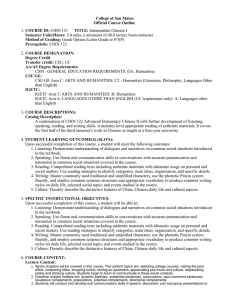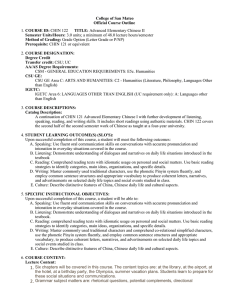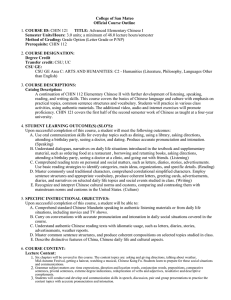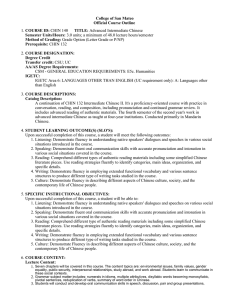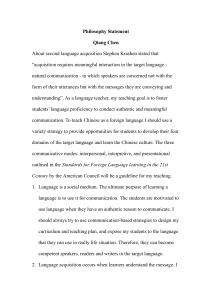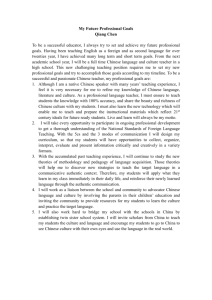College of San Mateo Official Course Outline COURSE ID: Semester Units/Hours:
advertisement
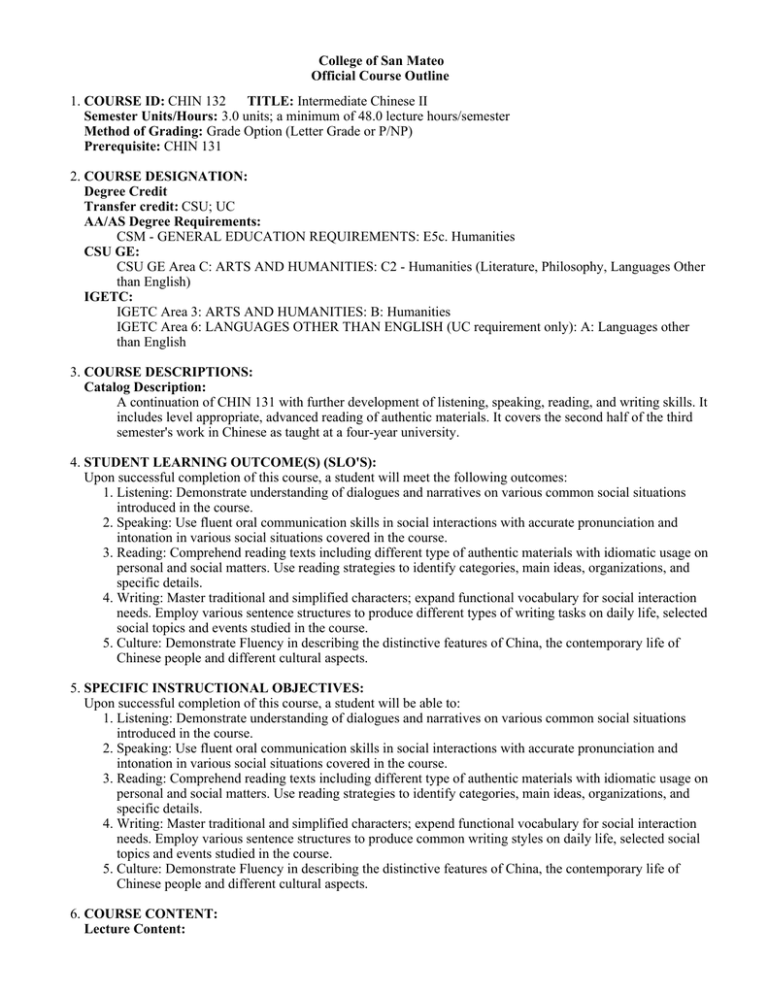
College of San Mateo Official Course Outline 1. COURSE ID: CHIN 132 TITLE: Intermediate Chinese II Semester Units/Hours: 3.0 units; a minimum of 48.0 lecture hours/semester Method of Grading: Grade Option (Letter Grade or P/NP) Prerequisite: CHIN 131 2. COURSE DESIGNATION: Degree Credit Transfer credit: CSU; UC AA/AS Degree Requirements: CSM - GENERAL EDUCATION REQUIREMENTS: E5c. Humanities CSU GE: CSU GE Area C: ARTS AND HUMANITIES: C2 - Humanities (Literature, Philosophy, Languages Other than English) IGETC: IGETC Area 3: ARTS AND HUMANITIES: B: Humanities IGETC Area 6: LANGUAGES OTHER THAN ENGLISH (UC requirement only): A: Languages other than English 3. COURSE DESCRIPTIONS: Catalog Description: A continuation of CHIN 131 with further development of listening, speaking, reading, and writing skills. It includes level appropriate, advanced reading of authentic materials. It covers the second half of the third semester's work in Chinese as taught at a four-year university. 4. STUDENT LEARNING OUTCOME(S) (SLO'S): Upon successful completion of this course, a student will meet the following outcomes: 1. Listening: Demonstrate understanding of dialogues and narratives on various common social situations introduced in the course. 2. Speaking: Use fluent oral communication skills in social interactions with accurate pronunciation and intonation in various social situations covered in the course. 3. Reading: Comprehend reading texts including different type of authentic materials with idiomatic usage on personal and social matters. Use reading strategies to identify categories, main ideas, organizations, and specific details. 4. Writing: Master traditional and simplified characters; expand functional vocabulary for social interaction needs. Employ various sentence structures to produce different types of writing tasks on daily life, selected social topics and events studied in the course. 5. Culture: Demonstrate Fluency in describing the distinctive features of China, the contemporary life of Chinese people and different cultural aspects. 5. SPECIFIC INSTRUCTIONAL OBJECTIVES: Upon successful completion of this course, a student will be able to: 1. Listening: Demonstrate understanding of dialogues and narratives on various common social situations introduced in the course. 2. Speaking: Use fluent oral communication skills in social interactions with accurate pronunciation and intonation in various social situations covered in the course. 3. Reading: Comprehend reading texts including different type of authentic materials with idiomatic usage on personal and social matters. Use reading strategies to identify categories, main ideas, organizations, and specific details. 4. Writing: Master traditional and simplified characters; expend functional vocabulary for social interaction needs. Employ various sentence structures to produce common writing styles on daily life, selected social topics and events studied in the course. 5. Culture: Demonstrate Fluency in describing the distinctive features of China, the contemporary life of Chinese people and different cultural aspects. 6. COURSE CONTENT: Lecture Content: 1. Seven chapters will be covered in this course. The content topics include: traditional Chinese medicine, Spring Festival, watching 1. Seven chapters will be covered in this course. The content topics include: traditional Chinese medicine, Spring Festival, watching 2. 3. 4. movies, human beings and animals, sports, popular jobs, relationships. Students learn to communicate in these social situations. Grammar subject matter includes: rhetorical questions, descriptive complements, adjectives as predicates, dynamic particle indicating experience, reduplication of measure words, end of sentence particles, comparative sentences. Students will conduct and develop oral communication skills in speech, discussion, pair and group presentations, debates to practice the content topics with accurate pronunciation, tone differentiation and intonation. Students will comprehend authentic reading materials and produce accurate translations of various types of writing samples with appropriate idioms and syntax. The cultural aspect is integrated in the content topics with extensive discussion of Chinese cultural customs associated with traditional and contemporary social occasions. 7. REPRESENTATIVE METHODS OF INSTRUCTION: Typical methods of instruction may include: A. Lecture B. Activity C. Critique D. Directed Study E. Discussion F. Guest Speakers G. Observation and Demonstration 8. REPRESENTATIVE ASSIGNMENTS Representative assignments in this course may include, but are not limited to the following: Writing Assignments: Writing assignments including various writing formats and content related to the chapter topics and supplementary material covered in the course, e.g. email, letter, narrative, dialogue, advertisement, essay, short cultural research project report, etc. Reading Assignments: Reading assignments including reading comprehension practice, stories, authentic materials, such as social reports in Chinese newspapers and periodicals, letters, advertisements, plays, subtitles in Chinese film, medicine instructions, relevant social research reports, etc. Other Outside Assignments: Listening and speaking assignments include recorded listening exercises, listening to authentic materials, such as phone conversations, TV shows, movies, etc. Perform pair or group designed dialogues, short plays, group projects, individual oral presentations, telling and interpreting idiom stories, report of research projects, simple debates, etc. 9. REPRESENTATIVE METHODS OF EVALUATION Representative methods of evaluation may include: A. Class Participation B. Class Performance C. Class Work D. Exams/Tests E. Final Performance F. Group Projects G. Homework H. Oral Presentation I. Papers J. Projects K. Quizzes L. Research Projects M. Written examination 10. REPRESENTATIVE TEXT(S): Possible textbooks include: A. activechinese.com. Active Chinese 200 Series, 2013 ed. activechinese.com, 2013 Possible software includes: A. Google Pinyin. Google, 2013 ed. Origination Date: February 2014 Curriculum Committee Approval Date: May 2014 Effective Term: Fall 2014 Course Originator: James Carranza Course Originator: James Carranza
